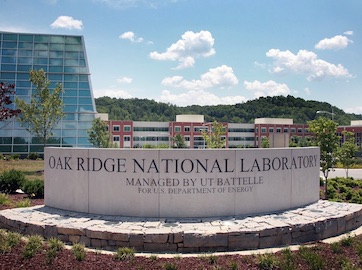Filter Results
Related Organization
- Biological and Environmental Systems Science Directorate (29)
- Computing and Computational Sciences Directorate (39)
- Energy Science and Technology Directorate (229)
- Fusion and Fission Energy and Science Directorate (24)
- Information Technology Services Directorate (3)
- Isotope Science and Enrichment Directorate (7)
- National Security Sciences Directorate (20)
- Neutron Sciences Directorate (11)
- Physical Sciences Directorate
(138)
- User Facilities (28)
Researcher
- Tomonori Saito
- Anisur Rahman
- Jeff Foster
- Diana E Hun
- Ying Yang
- Mary Danielson
- Syed Islam
- Zoriana Demchuk
- Alexei P Sokolov
- Alice Perrin
- Catalin Gainaru
- Isaiah Dishner
- Josh Michener
- Liangyu Qian
- Michelle Lehmann
- Natasha Ghezawi
- Ramesh Bhave
- Shiwanka Vidarshi Wanasinghe Wanasinghe Mudiyanselage
- Som Shrestha
- Soydan Ozcan
- Steven J Zinkle
- Vera Bocharova
- Xianhui Zhao
- Yanli Wang
- Yutai Kato
- Achutha Tamraparni
- Alex Plotkowski
- Alex Roschli
- Amit Shyam
- Andre O Desjarlais
- Benjamin L Doughty
- Bruce A Pint
- Christopher Ledford
- Corson Cramer
- Costas Tsouris
- Dali Wang
- Erin Webb
- Evin Carter
- Gerry Knapp
- Gs Jung
- Gyoung Gug Jang
- Halil Tekinalp
- James A Haynes
- Jeremy Malmstead
- Jian Chen
- John F Cahill
- Jong K Keum
- Karen Cortes Guzman
- Kitty K Mccracken
- Kuma Sumathipala
- Mengdawn Cheng
- Mengjia Tang
- Michael Kirka
- Mina Yoon
- Nicholas Richter
- Nick Galan
- Nick Gregorich
- Oluwafemi Oyedeji
- Patxi Fernandez-Zelaia
- Paula Cable-Dunlap
- Radu Custelcean
- Robert Sacci
- Ryan Dehoff
- Sanjita Wasti
- Santanu Roy
- Shailesh Dangwal
- Shannon M Mahurin
- Sumit Bahl
- Sunyong Kwon
- Tao Hong
- Tim Graening Seibert
- Tyler Smith
- Uvinduni Premadasa
- Weicheng Zhong
- Wei Tang
- Wei Zhang
- Xiang Chen
- Yan-Ru Lin
- Zhili Feng

We have developed a novel extrusion-based 3D printing technique that can achieve a resolution of 0.51 mm layer thickness, and catalyst loading of 44% and 90.5% before and after drying, respectively.

This invention utilizes a custom-synthesized vinyl trifluoromethanesulfonimide (VTFSI) salt and an alcohol containing small molecule or polymer for the synthesis of novel single-ion conducting polymer electrolytes for the use in Li-ion and beyond Li-ion batteries, fuel cells,

Enzymes for synthesis of sequenced oligoamide triads and tetrads that can be polymerized into sequenced copolyamides.
Contact
To learn more about this technology, email partnerships@ornl.gov or call 865-574-1051.

PET is used in many commercial products, but only a fraction is mechanically recycled, and even less is chemically recycled.

Developed a novel energy efficient, cost-effective, environmentally friendly process for separation of lithium from end-of-life lithium-ion batteries.

This work presents a novel method for upcycling polyethylene terephthalate (PET) waste into sustainable vitrimer materials. By combining bio-based crosslinkers with our PET-based macromonomer, we developed dynamically bonded plastics that are renewably sourced.

The invented alloys are a new family of Al-Mg alloys. This new family of Al-based alloys demonstrate an excellent ductility (10 ± 2 % elongation) despite the high content of impurities commonly observed in recycled aluminum.

V-Cr-Ti alloys have been proposed as candidate structural materials in fusion reactor blanket concepts with operation temperatures greater than that for reduced activation ferritic martensitic steels (RAFMs).

This invention is directed to a machine leaning methodology to quantify the association of a set of input variables to a set of output variables, specifically for the one-to-many scenarios in which the output exhibits a range of variations under the same replicated input

